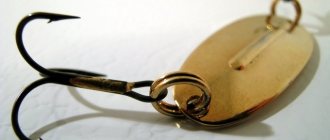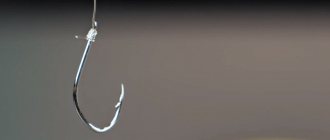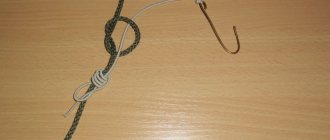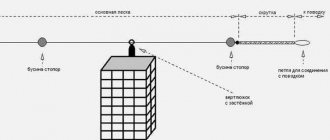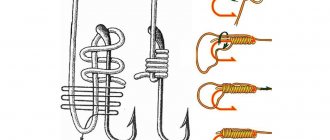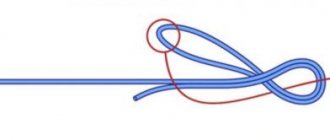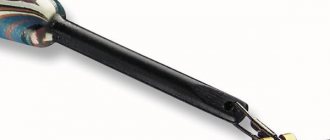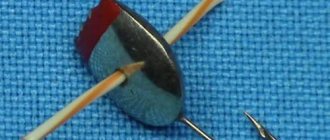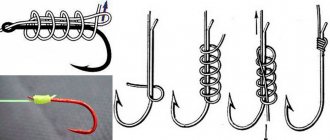So, we got ready to go fishing. Everything you need has already been prepared. But the issue of fishing knots remains important, especially for beginners. It should be understood that some knots work well on monofilament, others on braid, and others on fluorocarbon. There are knots that tie thin lines well, and others that tie lines of different diameters poorly.
In this article we will talk in detail about how to tie a leash to the main line (thin line to thicker line). In practice, you have to tie together a variety of types of fishing lines (fluorocarbon with monofilament, fluorocarbon with braid, monofilament with braid).
Water node
Used to connect the main line with the lead. A water knot is a type of surgical knot.
To tie a knot, take two fishing lines and fold them together so that there is a free end on the main fishing line. Then fold them in half to form a loop. Pull the loose ends into this loop. Before tightening completely, thread the ends through the loop 3 more times. Gently pull on the loose ends. Just before tightening, moisten the knot with water. This will make it stronger. Finally, cut off the free end of the lead.
Blood Knot for tying the leash to the main line
It is used to tie fishing lines of different thicknesses.
Take the two ends of the fishing line and connect them to each other. Loop one end of the line around the other. It is necessary to make at least six careful turns, then return to the beginning of the winding and thread the end of the winding end between the fishing lines. Then we wind the second end of the fishing line around the first. We return to the beginning of the winding, stretch the end between the fishing lines. The knot is ready, all you have to do is tighten it.
Albright
The most common type of knot for tying braid with monofilament.
Fold the main fishing line (stiffer or thicker) in half, forming a loop. You need to pass a thinner line through it and form a loop on the other, free side. Grab everything tightly with your fingers and start making turns with thinner fishing line. It is necessary to make approximately 8 - 10 turns. The turns should not run into each other. Then pass the formed end into a loop of thick fishing line. We slowly tighten the resulting knot.
Advice from experienced people
When buying this fishing line, you should focus on reliable and proven brands that follow production technology. This is the American company Owner, Japanese manufacturers: KUREHA, Sufix and Shimano. It is easy to distinguish real fluorocarbon line - just set it on fire.
The fake will continue to burn after the source of fire is removed from it, but the branded wood will immediately go out and a melted pellet will not form at its end; it will leave an ashy mark on your fingers.
A real fluorocarbon fishing line with its advantages, which will affect the number of fish caught, will be a godsend for the fisherman.
The main thing is to use it correctly and follow the recommendations when tying knots.
Read about how to choose a life jacket for safe fishing in our new article. We advise you to read the information on how to choose a life jacket for children?
Double sliding knot "Grinner" type
We will still give you one knot for tying the bait or hook to the leash. You never know how useful it will be.
Place one line on top of the other. From the top fishing line, form a loop, the end of which is returned back. Start wrapping it around the fishing line with the resulting loop. It is necessary to make at least 5 turns, then bring the end of the fishing line into the loop, wet it and carefully pull. The same must be done with the other end of the fishing line. When two knots are ready, pull the lines in different directions. The nodes will move towards each other. Trim the ends of the fishing line, leaving approximately 1.5 mm.
Knots for hooks, swivels, baits
For superiority in reliability for braided fishing lines, two knots are fighting among themselves - these are Uni and Palomar. Tests carried out on different cords showed that the Palomar knot can withstand a slightly greater load compared to Uni. Next in terms of reliability is a modified version of the Clinch knot - “Improved Clinch”.
Of course, these knots are suitable for tying anything on both regular nylon and fluorocarbon fishing line.
Palomar
The Palomar knot is one of the most reliable and simple fishing knots for braided fishing line and monofilament (Palomar knot, hinged knot). Often used for tying various hooks, baits, snap hooks and swivels.
Some tips for beginners
- Practice tying knots at home first. It is important for you to hone this skill in a calm environment, to bring the actions to automaticity.
- Before tightening the knots, wet them - this will help them hold tighter. This is especially important for monofilament and fluorocarbon. When tightening dry fishing line, it “burns out” and becomes more severely deformed.
- Do not burn the ends with a lighter. You can damage the quality of the fishing line itself and the strength of the knot.
- Experienced fishermen recommend keeping fishing line with a diameter greater than 0.3 mm in warm water. Then it will become softer. But it is important to remember that such fishing line is more easily deformed and knots should be tied very carefully. Some people advise laying silk or cotton thread before tying a knot.
- In braided cord, friction during tightening greatly affects the strength of the knot.
- An improperly tightened knot can cut itself.
Follow these tips and you will definitely succeed. In the comments, share your nodes, as well as tips for using existing ones.
primanki.com
In modern
spinning fishing, cords (braid) are mainly used. Also, in addition to braided line, various auxiliary leader materials are used: monofilament fishing lines; metal driving materials; fluorocarbon . Today's review will focus on knots used for tying fluorocarbon leashes and for connecting fluorocarbon to braided cord .
The topic is relevant and interesting, so we’ll look into it. Let's consider two options. First: we have thick fluorocarbon (more than 0.4mm) and we will use it to make regular leashes for heavy spinning rods. Second: a light spinning rod with 0.06-0.1mm cords and we tie a piece of thin fluorocarbon to it as a leash .
Why thick fluorocarbon instead of regular metal leaders? Fluorocarbon, even thick, is not noticeable in the water. Thick fluorocarbon is quite rigid and therefore has a high probability of not being cut off by pike teeth. So, a leash made of thick fluorine, 30-40 cm long, will be much less noticeable than a metal one, and in terms of effect, in terms of protecting the gear from pike teeth, it will be close to the latter.
Why use thin fluorocarbon ? Its thickness and rigidity are clearly not enough to withstand pike teeth. But it is very inconspicuous in the water, compared to the cord. So, there is a reason to attach the bait not directly, through an American fastener, but to install a meter-long leash made of thin fluorocarbon. Such a leash will come in handy when light fishing for perch, chub, asp.
Knots for tying the ends of thick fluorocarbon into leash loops. As usual, a swivel and a large American clasp are attached to the loops. I use the Rapala knot (picture). You can also use crimp tubes (but press carefully so as not to cut the material with the edges of the tube).
Alternatively, you can use the traditional Palomar knot.
“Carrot” knot , for tying a cord (braid) with thin fluorocarbon or monofilament.
At the end of the fluor we make a simple single knot and while we leave it loose, do not tighten it.
We pull the end of the cord into this knot and stretch it 15-20cm. We make a dozen turns of the cord around the fluorocarbon in the direction from the knot. We don’t place coils very often. The resulting winding is 3-4 cm long. Then another dozen turns in the opposite direction, towards the knot, on top of the first series of turns. All this time we hold the place where the cord enters the knot on the fluor so that the structure does not spin. So, having reached the knot, we again pass the end of the cord into the knot on the fluor. Pull the ends of the cord so that the winding is tight.
Then, tighten the knot on the fluor. We cut the end of the fluor 5-7mm above the knot. Pull the ends of the cord. It is slippery and stretches perfectly even through a tightly tightened knot on fluorocarbon (fishing line). In this way we tightly tighten the turns of the cord winding. We tie the end of the cord into a simple double knot, throw it over the flurry below the knot and tighten it. We cut off the excess cord. We burn the fluor horses with a lighter (carefully). And flatten it slightly. Here the guys tried to film it.
nik-fish.com
Types of knots for fluorocarbon line
Due to friction, fluorocarbon line assemblies often overheat and become damaged. To avoid this phenomenon, it is best to wet the surface of the fishing line with water. Fluorocarbonate requires a large number of weaves in the loops, with their help the knots are strong and durable.
Carrot (Mahin Knot)
Most often used to attach a leash to braid. It is done in several stages:
- Make a regular knot at the end of the leash, do not tighten it all the way.
- A braid is pulled into the same knot for a length of about 15 mm. Next you need to make 10 revolutions forward and six back along the fishing line. It is best if the turns can be arranged in a checkerboard pattern.
- The resulting fastener is generously wetted with water; for additional reliability, the knot must be tightened tightly. The remaining fluorocarbonate is cut 5-10 mm above the node.
The result should be a very strong knot that is almost impossible to notice in the water.
Albright
Indispensable if there is a significant difference in the diameters of the fishing lines. It makes it easy to connect braided and fluorocarbon line. This is done in a few simple steps:
- Fold the material with a larger diameter (fluorocarbonate) in half, leaving a small loop.
- A second line is pulled into the hole formed. After a short distance, a winding is made around the loop.
- To be reliable, you need to make at least seven revolutions. The end of the thin line is pulled back through the first loop.
- The resulting fastener is tightened tightly, the excess ends are trimmed.
This combination of two materials allows you to make a fairly long leash that will be invisible to fish in the water. The diameter of the fluorocarbon line can be up to three times thicker than the second material.
Grinner
It is considered a universal fastening method. Also used for tying a swivel to monofilament and fluorocarbon fishing line. To tie this node, you need to perform four steps:
- The end of the line passes into the ring of the swivel. For additional reliability, you need to thread at least 15 cm.
- The released tip is applied back to the fishing line. This creates a small loop. Now you need to press the loop with your finger and turn the end of the line back to the swivel.
- By passing the tip under both sides of the fishing line, make the winding further from the loop. You need at least five turns for reliability
- Tighten the fishing line, trim off any unnecessary residue with a knife or scissors.
Rapala
Knots for fluorocarbon line and hook require more strength, rapala is one of these:
- A loop is tied at a distance of approximately 10 cm from the end of the fishing line. It doesn't need to be tightened.
- The tip of the fluorocarbon is threaded through the ring on the swivel and returned to the loop. The fishing line is pulled through it so that a large and small loop is formed.
- The end of the fishing line is threaded through a large loop, the fastening is tightened and cut.
Brief information about fluorocarbon
Before we start talking about leashes, let’s figure out what fluorocarbon is and what its main characteristics are.
Fluorocarbon fishing lines are produced using technologies similar to nylon monofilaments. The only starting material is polyvinylidene fluoride, known to many as fluoroplastic.
After heating and leveling, the material is cooled and the threads are pulled, which later become fluorocarbon fishing line.
The resulting material has the following characteristics:
- uniformity in length;
- minimal stretchability;
- rigidity;
- invisibility in water;
- protection from sunlight;
- increased frost resistance compared to nylon;
- lack of memory;
- abrasion resistance.
Fluorocarbon production is more expensive, so fishing lines are expensive and are rarely used as working lines.
Types of leashes
Fluorocarbon fishing line for leashes should be selected depending on the upcoming fishing conditions, because this material can be used in several fishing guises:
- as a leader material for spinning rigs;
- for leashes of float and bottom gear;
- as a replacement for metal when catching a passive predator.
Spinning montages
Fluorocarbon leader is used in the manufacture of spaced rigs, such as:
- diverter leash;
- Texas;
- Caroline;
- split shot
The choice of this material is justified by several factors:
- The rigidity of the fluor and its low elongation do not weaken the tactile sensations compared to the use of monofilament.
- Relative invisibility in water does not unmask the bait.
- Abrasion resistance allows the equipment to be used on rocky or shell bottoms for a long time.
Leash for peaceful fish
Increasingly, anglers have begun to use fluorocarbon to make leashes for float or bottom fishing rods. This is especially often used when catching small, peaceful fish weighing up to one kilogram:
- roach,
- crucian carp,
- rudd,
- dace,
- white bream.
It is these fish that are the most shy, and often equipping a fishing rod with fluorocarbon is the key to successful fishing. Moreover, the diameter of such a fishing line can be quite small by fishing standards. Modern fluor with a diameter of 0.14 millimeters can withstand a breaking load of more than a kilogram.
On a note! The choice of leader thickness should correspond to the diameter of the main fishing line and should not be stronger than its tensile strength.
Leash for a predator
In some cases, it is necessary to tie a leash made of fluor for tackle on a predator. In this case, there are more bites than with metal inserts, although there is a risk of losing the bait.
It is advisable to use fluorocarbon in the following gear:
- girders,
- mugs,
- put it on,
- live bait floats,
- jig.
Of course, it is worth replacing metal leashes with fluorocarbon ones in cases where the toothy predator is passive and is careful not to approach the bait. The effect is especially noticeable on circles in the summer thermocline or on zherlits and postavushas in the middle of nowhere.
You can catch perch, pike perch and white predators with fluor leashes without fear of breaking or biting. But if there is a possibility of active pike biting, it is better not to risk baits and use metal or Kevlar.
Recommended fluorocarbon diameters for some predators:
- perch - 0.20 millimeters;
- pike in winter - 0.30 millimeters;
- pike perch and pike in summer - 0.40 millimeters.
Advantages and disadvantages of such connections
The advantages of these connections include:
- Firstly. The fishing line is designed specifically for this type of fishing line and looks neater and smoother than when tying cord and monofilament.
- Secondly. Invisibility, thanks to the above-described properties of fluorocarbon material, which makes the joint invisible to fish.
- Third. Good wear resistance - the joints do not fray or fray when rubbing against bottom stones.
- Fourthly. Quietness when moving in the water column - the inertness of the material does not allow it to absorb moisture and swell while remaining in water for a long time.
There are not many disadvantages to this connection plan, but they are present. One of which is the rigidity of the scaffolding material, which can cause discrepancies in the tied connections if they are made incorrectly or of poor quality.
The second negative factor was the lower strength of such a connection than one made from a cord or monofilament of a similar diameter, which can easily be corrected by purchasing a thicker fishing line.
Making leashes
Making fluorocarbon leashes is not as easy as it might seem at first glance. The rigidity of the material does not allow the use of simple knots, which are good on braid or nylon monofilament.
You need to knit flurry with strictly defined knots, among which the following are considered the best:
- carrot,
- double eight,
- Grinner.
However, a very simple and elegant method is now used to make leashes - using crimping tubes made of soft metal. The technology for creating leashes is very simple:
- Take a piece of fluorocarbon of the required length.
- We thread one of the ends into a tube; its diameter should exceed twice the thickness of the fishing line.
- We put a swivel or carabiner on the fishing line for subsequent attachment to the equipment or shock leader.
- Place the end into the tube again and align the loop to the desired size.
- Using pliers, squeeze the tube from one end.
- Rotate the part 90 degrees and crimp it from the other end.
- We do the same at the other end or tie the hook using one of the methods recommended above.
You can store finished leashes on fishing line spools, pieces of foam plastic, in leash holders or other similar devices.
Knots for tying fishing line
The best, most durable and reliable knots for tying any type of fishing line. These knots are suitable for both braid and fluorocarbon.
Let's start with a universal knot that allows you to tie fishing lines of different types and diameters together.
Albright
This knot can be used to tie braided line and fluorocarbon or nylon line, fluorocarbon line and nylon. The knot is called Albright knot, and it cannot be replaced if you need to tie fishing lines that differ significantly in diameter.
How to tie an Albright knot:
Carrot
The Carrot Knot is one of the most reliable knots for fluorocarbon and braid or regular fishing line that are tied together. In spinning fishing, this knot is used to tie together braided line and fluorocarbon leader. In carp fishing, it is mainly used to connect the shock leader to the main fishing line.
Braid or regular monofilament is wrapped around stiffer fluorocarbon, and the softer and thinner the line, the more turns are made.
How to tie a Carrot knot:
Pros and cons of fishing thread
The main advantages of fluorocarbon thread in fishing are as follows:
- Stealth in water. The main property of this fishing line is why fishermen love it. Often when fishing with a spinning rod or a float, the fish, seeing the fishing line, are very reluctant to approach the bait. Of course, you can take the fish by cunning. For example, feeder fishing involves keeping the fishing line on the ground. But it is much easier to take an inconspicuous fluorocarbon line for pike leaders.
- Elasticity. This thread is much less susceptible to bending or deformation than monofilament.
Its main disadvantage is the low level of strength. But this problem can also be solved. The main thing is to remember that when choosing a strong fluorocarbon fishing line, you need to pay attention to its breaking load, and not to the diameter. The strength of the leash should be 10-20% less than the strength of the main line. You don’t have to worry that the thickened leash will be visible in the water - it definitely has fluorocarbon invisibility.
Another disadvantage is rigidity. This property of the thread negatively affects the strength of the knots. If the knots are made incorrectly, then due to their high rigidity they will either not tighten at all or will quickly come apart. Therefore, it is recommended to make knots very tightly, using as many weaves as possible.
Another weak point of invisible fishing line is the price. Fluorocarbon thread is the most expensive option when choosing fishing equipment. The reassuring thing is that it will be enough to buy only 10-20 m, this small amount will last for a long time. The fact is that fluorocarbon is used only in leashes (their length is only from 1-3 m to literally 20-30 cm), and not as the main fishing line.
Areas of use
Manufacturers produce two types of fishing line made from fluorocarbon material: soft and hard.
The soft version is thinner and is perfect for catching small fish with a float in the summer, using it like a regular line. In winter, it will work well when fishing with a balance beam, spoon or jig.
Rigid types of lines made from this material are used on leashes for various types of fishing in fishing for predatory and peaceful fish:
- Spinners use such a leash, tying it to a colored cord or bright monofilament so that the fish do not notice them, in front of the bait. Typically, the length of such a leash ranges from one to three meters.
- Fly fishermen tie leashes of this type, hoping that the fish will perceive a fly that has fallen on the water as a natural bait, given the “invisibility” of the fluorocarbon material.
- When fishing with a feeder, a diverter leash made of this material becomes invisible to the fish, being above the bottom surface.
There are fishermen who avoid using fluorocarbon line, believing the claims that the knots it makes are weak and unravel on their own.
This is true, but in part, for fishing lines made of various materials there are strong knots, you just need to be able to and know how to knit them.
For more information on what feeder equipment is, see here.
How is fluorocarbon used?
It began to be used relatively recently, but despite this, now its use has increased even more: it is used both as the main fishing line and for creating leashes.
But often fishermen refrain from using fluorocarbon thread, because its use requires that the knots be treated with care and precision due to their fragility compared to conventional fishing lines, and it costs much more than conventional fishing lines. The most effective use of fluorocarbon can be achieved with such fishing methods as:
- Dropshot. Equipment designed for fishing with spinning baits. It is attached to the main line with a carabiner or loops. The hook is attached to the fluorocarbon, and the sinker is placed a little lower. A high ability to make confident hooks is achieved due to the feeling of contact with the bottom.
- Jerkbaits. Fluorocarbon is perfect for deep diving wobblers. It slightly restrains the yaw movements of the jerk bait, but most often this fact even shows a positive effect.
- Flipping. Special movements of the tackle, with the help of which it is possible to maneuver the thickets in the shallows. Here fluorocarbon allows the bait to sink lower and slide smoothly between underwater bushes. The frequency of bites, as a rule, with this type of fishing line is much higher than with braided fishing line.
- Spinnerbashing. Artificial bait with the possibility of adhesion to underwater thickets is eliminated due to the bait, which is located vertically. Fluorocarbon is used here when fishing near the bottom in clear water.
Practical knots for fluorocarbon
One of the blog posts already discussed the option of how to make your own fluorocarbon leash for pike fishing. Today we will talk about knots that can be used when tying fluorine leashes to the main monofilament or braided line, as well as attaching hooks to fluorocarbon leashes.
I think the idea of using fluorocarbon as the main line when working with a spinning reel should be a separate topic. So as not to waste water, as they say, “closer to the body.”
The rigidity of the fluor often does not allow one to count on high-quality execution of the knots. They unravel, turn out to be quite voluminous, and do not always tighten properly. However, this hassle can be avoided if you use knots recommended by the manufacturer and fishermen.
I don’t use crimp tubes even when making leads from titanium and lead material, for example from Pontun 21. I think this is unnecessary. A specialized node means a more reliable connection.
